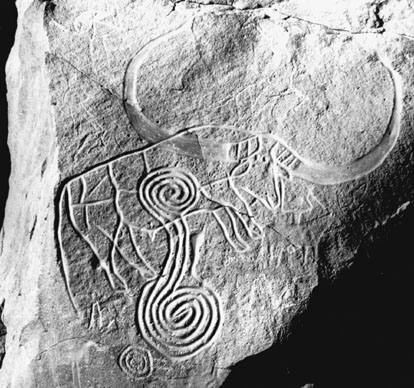

 | Page 45 |  |
peoples and state founders (Egyptians, Ethiopians, Bejas, and Semites), in other words by the white race. Seligman went so far as to specify that the incoming Hamites were pastoral “Europeans.” The virtual parallel with the colonization, or “civilizing,” of Africa by Europeans went without saying!

Giant buffalo (ca. 4000–2000 b.c.), Oued Djerat (Tassili, Algeria), about 125 cm. in length
(Alfred Muzzolini)
Another widely shared but unsubstaniated thesis was diffusionist in nature. People were trying to find out whether the art of the Spanish Levant derived from Saharan art or vice versa. Indeed, many scholars, among them abbé breuil, in contrast with Flamand, argued a Paleolithic age for the art of the Saharan Atlas. Breuil was seeing things on a grand scale, linking three arts: the European Paleolithic art of the Magdalenian caves and that of the allegedly Paleolithic Levant with Saharan art, which was often linked with the Capsian period. The latter was linked by Breuil and others to the European Aurignacian, and with South African art that many thought to be very old. All three were said to have exchanged stylistic conventions and themes. Links were also made with predynastic Egypt.
This diffusionist way of thinking always had deep influences on Saharan research. In the long run the accumulation of documentary evidence, obviously different over the diverse regions, and later carbon–14 dates led to the abandonment of Breuil’s grandiose but false theories of relationships between Spain, Sahara, and South Africa. But the idea that cultural features could be pan-Saharan—that at least the whole Sahara could be treated as a single culture area—persisted,